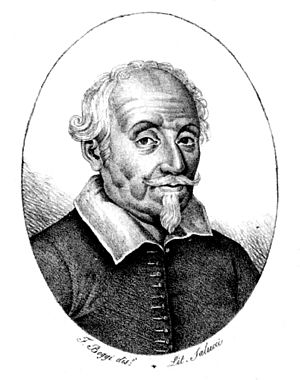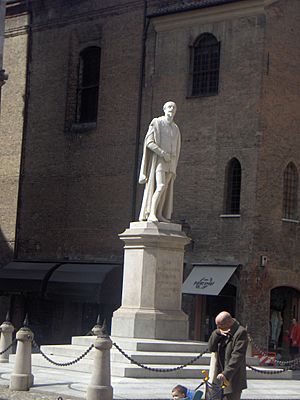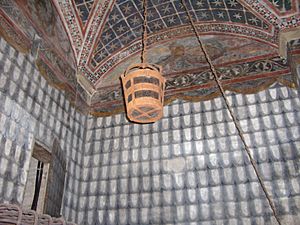Alessandro Tassoni facts for kids
Quick facts for kids
Alessandro Tassoni
|
|
|---|---|
 |
|
| Born | 28 September 1565 Modena, Duchy of Modena and Reggio |
| Died | 25 April 1635 Modena, Duchy of Modena and Reggio |
| Nationality | Italian |
| Other names | Aldrovinci Melisone |
| Alma mater |
|
| Occupation | Writer, poet, literary critic |
| Works | La secchia rapita |
| Movement | Baroque |
Alessandro Tassoni (born September 28, 1565 – died April 25, 1635) was a famous Italian poet and writer. He was from Modena, a city in Italy. He is best known for his funny, long poem called La secchia rapita, which means The Stolen Bucket. This poem is a type of story called a mock-heroic poem, which makes fun of serious epic poems.
Contents
About Alessandro Tassoni's Life
Alessandro Tassoni was born into a noble family in Modena. Sadly, he lost both his parents when he was very young. His grandfather, Giovanni Pellicciari, raised him. It's said that his grandfather took him to see a special bucket in the bell tower of Modena's Cathedral. This bucket later gave Alessandro the idea for his most famous poem.
Early Education and Studies
When Alessandro was 13, he learned Greek and Latin from a literature professor named Lazzaro Labadini. After that, he decided to study law. He went to universities in Modena, Bologna, Pisa, and Ferrara, where he eventually finished his studies.
He was known for being a bit wild when he was young. He even lived for a while in a town called Nonantola. In 1595, he had to leave Nonantola because he was involved in some local incidents.
Working for Important People
In 1597, Alessandro Tassoni started working for Ascanio Colonna, an important church leader called a cardinal. He even traveled to Spain with him. In 1589, he became a member of the Accademia della Crusca, a famous Italian language academy. By 1603, he was back in Italy and living in Rome.
In 1612, he secretly published a small book called Le Filippiche. In this book, he criticized Spain's control over parts of Italy. Even though he always said he didn't write it (probably because he was worried about Spain's reaction), the book became very well-known. It helped him get a job with Charles Emmanuel I, Duke of Savoy, who hired him in 1618 as his "first secretary" in Turin.
Later, Tassoni worked for another cardinal, Ludovico Ludovisi, in 1626. He also served Francesco I d'Este, the Duke of Modena, in 1635.
Alessandro Tassoni passed away in Modena. The people of Modena remembered him and his work with a statue. You can still see this statue today in front of the Ghirlandina, which is a famous tower and symbol of the town.
Alessandro Tassoni's Works
Besides Le Filippiche, Alessandro Tassoni wrote other important works. Some were poems, and some were literary criticism. Literary criticism means writing about and judging other people's books and poems.
Important Writings
One of his critical works was called Varietà di pensieri di Alessandro Tassoni, which means "Diverse Thoughts by Alessandro Tassoni." He also wrote Considerazioni sopra il Petrarcha in 1609. This book showed that he had his own ideas about literature, different from what people usually thought.
However, Alessandro Tassoni is most famous for his mock-heroic poem, La secchia rapita (The Stolen Bucket). Because of this poem, he is remembered as Modena's special poet.
The Stolen Bucket Poem
Tassoni wrote La secchia rapita between 1614 and 1615. It was first printed in Paris in 1622. He couldn't publish it in Italy right away. He had to change it a little bit to make sure the Catholic Church approved of it. Tassoni paid for the first Italian version, which had his real name on it, in 1624. Before that, the poem was shared under a fake name, Aldrovinci Melisone. The final version of the poem came out in 1630.
The Story Behind the Poem
The poem is loosely based on a real war that happened in 1325. This war was fought between the cities of Modena and Bologna at the battle of Zappolino. But most of the events in Tassoni's poem are made up. He even included the battle of Fossalta, which happened almost a hundred years earlier, into his story.
The main part of the poem is about the people of Modena stealing a bucket from their rivals in Bologna. Interestingly, the main historians from that time don't mention this bucket theft. However, there is a bucket that people say is the actual trophy from that battle. It has been on display in the basement of the Torre della Ghirlandina (Ghirlandina Tower) since the time of the battle until today.
Gods and Popes in the Story
In the poem, the theft of the bucket causes a very complicated war to break out. Even the ancient Greek and Roman gods, like those from Homer's Iliad, get involved in the fighting! This was a common idea in very old, serious poems. In the end, the Pope steps in to stop the war. Tassoni also included jokes and references to people and situations from his own time in the story.
See also
 In Spanish: Alessandro Tassoni para niños
In Spanish: Alessandro Tassoni para niños



